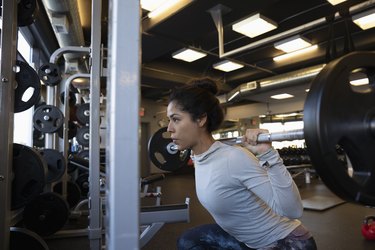
Muscular strength refers to the overall energy a muscle can exert in a single effort. With regular hard work, muscular strength exercises will improve your muscles' ability to handle heavy weight. Exercising with free weights, machines, barbells, dumbbells and body weight is a good starting point.
Video of the Day
Video of the Day
Benefits of Muscular Strength Workouts
There are numerous benefits to picking up heavy weights. Strength training improves muscular strength by gradually building up your muscles, tendons, ligaments and bone strength.
By challenging your muscles with increasing weight and repetitions, you stress them. The added stress causes muscle fibers to break down, notes the American Council on Exercise, and then repair and grow through a process called hypertrophy.
Significant increases in muscle fiber hypertrophy begin to appear after approximately 16 muscular strength workouts. While your muscles increase in size, your increase in strength is due to the resistance in training, which develops more efficient neural pathways to your muscles.
Additional benefits include increased bone mass, which helps prevent osteoarthritis and reduce the risk of fractures, according to the American Cancer Society. Your body will burn calories more easily as you gain muscle mass, making it easier to lose or maintain weight. Stronger muscles also give you greater balance and boost flexibility, reducing falls and injuries.
The Sport of Power Lifting
Power lifting is designed to test a weight lifter's absolute strength through explosive movements with heavy loads. The fundamental exercises are the squat, the bench press and the deadlift. These muscular strength exercises require pushing, pulling and squatting, which are the core forms of power lifting.
Improving your muscular strength through power lifting will require muscular strength workouts that focus on lowering your repetitions and training with heavy weights. Working with an experienced trainer will help you nail the proper form and reduce your risk of injury.
That risk is real, according to a May 2018 study published in the Orthopaedic Journal of Sports Medicine. The study found that 70 percent of the male and female power lifters surveyed were currently injured, and 87 percent had been injured in the previous 12 months. The body parts most frequently injured were the lumbopelvic region, shoulders and hips for both men and women.
Additional Muscular Fitness Exercises
Some muscular fitness exercises include compound exercises, which are multi-joint exercises that rely on the coordinated actions of several muscle groups to build muscular strength. An example is the squat because it uses your hips, knees and ankles, putting increased strain on your quads, glutes, hamstrings, back, abdomen and a multitude of small stabilizing muscles.
Muscular strength exercises with compound movements should range from eight to 12 reps and use heavy loads. Bench press, military press, rows, squats and deadlifts are common compound exercises. Three to five sets are commonly performed.
Other types of muscular fitness exercises focus on body weight training, which forces you to use your own body weight as resistance. Upper-body exercises include push-ups, pull-ups, chin-ups and dips. Improve your chest and biceps workouts by performing four sets of 15 to 20 reps for each exercise. Lunges and squats are popular lower-body exercises, and sit-ups and crunches will strengthen your core.
- American Cancer Society: "5 Benefits of Strength Training"
- American Council on Exercise: "Four Ways to Help Your Body Recover From a Big Lift Day"
- National Center for Biotechnology Information: Orthopaedic Journal of Sports Medicine: "Prevalence and Consequences of Injuries in Powerlifting: A Cross-sectional Study"
- Flex Fitness Center: Building Better Bodies
Was this article helpful?
150 Characters Max
0/150
Thank you for sharing!
Thank you for your feedback!